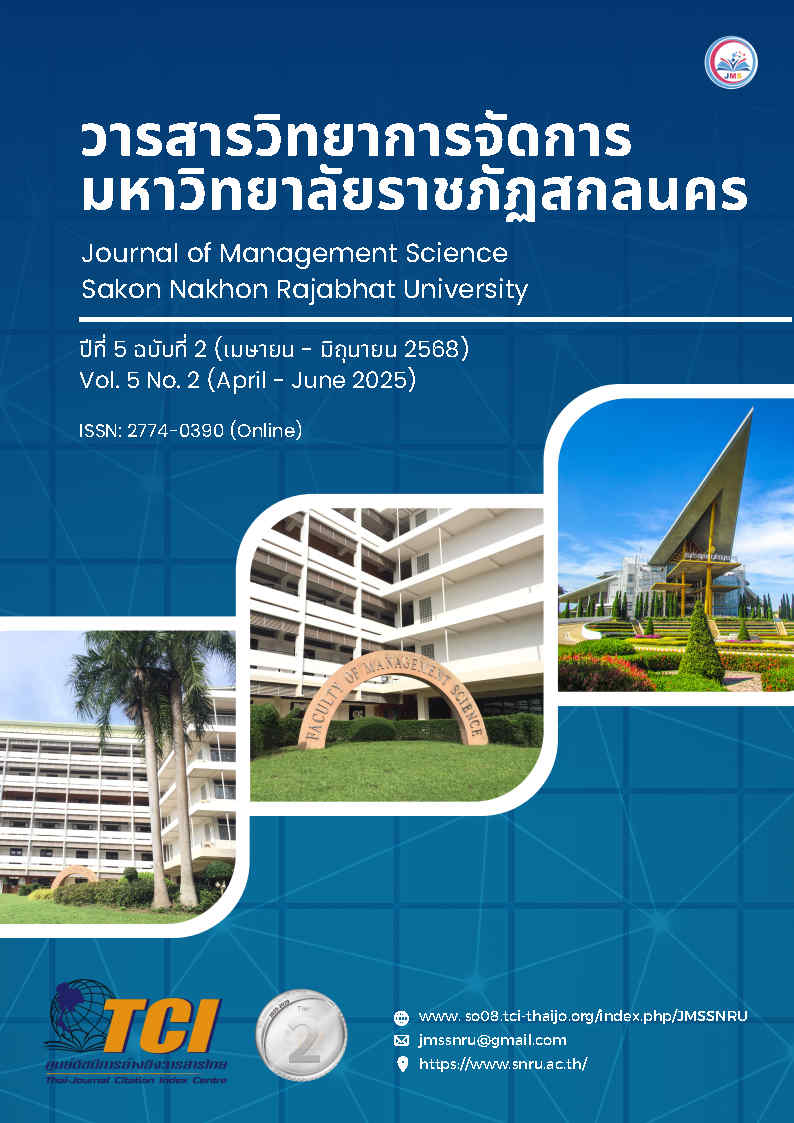Facebook fanpage customers segmentation based on distinctive characteristics under The STP strategy
Keywords:
customer segmentation, cluster analysis, K-prototype algorithm, STP strategyAbstract
This quantitative research aimed to cluster Facebook Fanpage customers according to their distinguishing features under the STP strategy using the k-prototype clustering technique. The sample was 389 people who were used to buying products via their Facebook fan pages by using convenience sampling. The research instrument was a questionnaire with an item congruence index of over .5, an item content validity index of 1.00 for each item, and a Cronbach's alpha coefficient of .901. The data were collected online between July and October 2022. The study revealed that Facebook Fanpage customers are segmented into three groups according to their outstanding characteristics: the first group is a group of teenage online shoppers who buy little but are easily satisfied (62.98 percent); the second group is a group of online shoppers with high expectations (35.22 percent); and the third group is a group of online shoppers who give importance to the quality of products and have high purchasing power (1.80 percent).
References
ชัดชัย แก้วตา และชนัญกาญจน์ แสงประสาน. (2564). การเลือกพืชสวนเศรษฐกิจเพื่อการเพาะปลูกที่เหมาะสมในจังหวัดอุบลราชธานีโดยใช้เทคนิคการทำเหมืองข้อมูล.วารสารวิทยาศาสตร์บูรพา, 26(1), 593-609
ณรรฐคุณ วิรุฬห์ศรี, ลัทธพล โชครัตน์ประภา, ณัฐณิชา ศรีสมาน และ พรทิพย์ เดชพิชัย (2565) การวิเคราะห์แบ่งกลุ่มลูกค้าโดยใช้พฤติกรรมการซื้อเชิงลึก: กรณีศึกษาบริษัทผู้ผลิตอาหารสัตว์เลี้ยงแห่งหนึ่ง. วารสารวิทยาศาสตร์ลาดกระบัง, 31(1), 103-119.
ดารณี พิมพ์ช่างทอง. (2561). การวิเคราะห์จัดกลุ่มเพื่อการรณรงค์ทางการตลาดด้วยการใช้เครือข่ายสังคมออนไลน์. RMUTT Global Business and Economics Review. 13(1), 139-150.
บริษัทฝึกอบรมและสัมมนาธรรมนิติ. (2563). 5 Generations ความต่างที่คุณต้องรู้. สืบค้น 14 ตุลาคม 2565, จาก https://www.dst.co.th/index.php?option=com_content&view=article&id=3938:5-generations-difference&catid=29&Itemid=180&lang=th.
ปารณีย์ พึ่งวิชา, อานนท์ ทับเที่ยง และธัญญา สัตยาอภิธาน. (2562). ศึกษาการแบ่งกลุ่มพฤติกรรมของผู้บริโภคที่ซื้อเครื่องประดับ ผ่านเครือข่ายสังคมออนไลน์. วารสารมนุษยศาสตร์และสังคมศาสตร์ มหาวิทยาลัยราชพฤกษ์ ฉบับเสริม, 212-224.
วณิชา แผลงรักษา และนิเวศ จิระวิชิตชัย. (2562). การแบ่งกลุ่มลูกค้าโดยใช้เทคนิคการทำคลัสเตอร์แบบเคมีน สำหรับการบริหารลูกค้าสัมพันธ์. วารสารวิชาการซายน์เทค มรภ.ภูเก็ต, 3(2), 1-10.
Armstrong, G., & Kotler, P. (2017). Marketing: An Introduction (13th ed). Boston: Pearson Education, Inc.
Chaffey, D., & Ellis-Chadwich, F. (2016). Digital Marketing: Strategy, Implementation and Practice (6th ed). Pearson Education Limited.
Dataxet. (2566). เฟซบุ๊กและไลน์นั่งแท่นสื่อโซเชียลมีเดียยอดนิยม. สืบค้น 1 กุมภาพันธ์ 2566 จาก https://www.dataxet.co/media-landscape/2023-th/social-media
Han, J., Kamber, M., & Pei, J. (2012). Data Mining: Concepts and Techinques (3rd ed). Massachusetts: Elsevier.
Hayasaka, S. (2022). How Many Clusters? Methods for choosing the right number of clusters. สืบค้น 8 ตุลาคม 2565, Retrived from https://towardsdatascience.com/how-many-clusters-6b3f220f0ef5.
Husein, A. M., Waruwu, F. K., Batu Bara, Y. M. T., Donpril, M., & Harahap, M. (2021). Clustering Algorithm For Determining Marketing Targets Based Customer Purchase Patterns And Behaviors, Jurnal dan Penelitian Teknik Informatika, 6(1), 137–143, https://doi.org/10.33395/SINKRON.V6I1.11191
Islam, M. R. (2018). Sample size and its role in Central Limit Theorem (CLT). International Journal of Physics & Mathematics, 1(1), 37-47. https://doi.org/10.31295/ijpm.v1n1.42.
Kansal, T., Bahuguna, S., Singh, V. K., & Choudhury, T. (2018). Customer Segmentation using K-means Clustering. International Conference on Computational Techniques, Electronics and Mechanical Systems (CTEMS), 135-139, https://doi.org/10.1109/CTEMS.2018.8769171.
Kemp, S. (2022). Digital 2022: Thailand. สืบค้น 1 ตุลาคม 2565, จาก https://datareportal.com/reports/digital-2022-thailand?rq=facebook%20thailand%202022.
Kotler, P., & Armstrong, G., (2018). Principles of Marketing (17th Global ed.). UK:Pearson Education, Limited.
Nandapala, E. Y. L., & Jayasena, K. P. N. (2020). The practical approach in Customers segmentation by using the K-Means Algorithm. 2020 IEEE 15th International Conference on Industrial and Information Systems (ICIIS), 344–349. https://doi.org/10.1109/ICIIS51140.2020.9342639.
Szepannek, G. (2018). clustMixType: User-Friendly Clustering of Mixed-Type Data in R. The R Journal. 10(2), 200-208.
Yang, H., shi, C., Cai, J., Zhou, L., Yang, Y., Zhao, X., He, Y., & Hao, J. (2022). Data mining techniques on astronomical spectra data – I. Clustering analysis. Monthly Notices of the Royal Astronomical Society, 517(4), 5496–5523. https://doi.org/10.1093/mnras/stac2975.
Downloads
Published
How to Cite
Issue
Section
License
Copyright (c) 2025 JOURNAL OF MANAGEMENT SCIENCE SAKON NAKHON RAJABHAT UNIVERSITY

This work is licensed under a Creative Commons Attribution-NonCommercial 4.0 International License.
An article published in the Journal of Management Science. Sakon Nakhon Rajabhat University is the opinion, copyright and responsibility of the author of the work.







